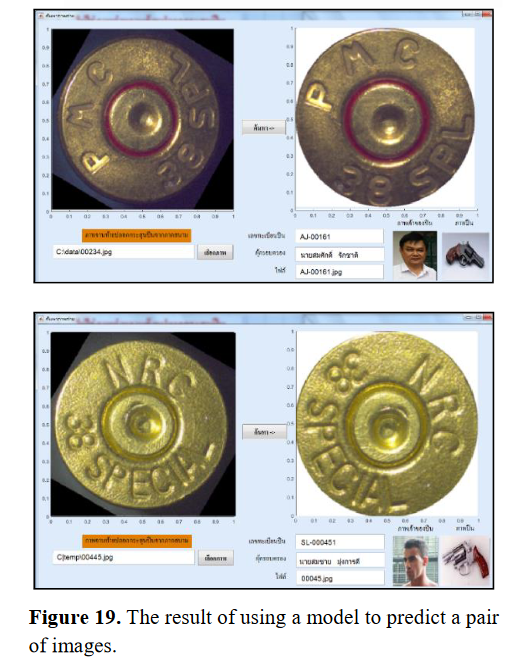The System Recognizes the Digital Image of Pistol Shell Casings by Developing Algorithms Combined with Deep Learning
DOI:
https://doi.org/10.53848/ssstj.v10i2.515Keywords:
Pistol, Shelling gun, Breech Face Digital Image, image of pistol shell casingsAbstract
Gun-related violence in Thailand is in a high rate. Resume reports showed that most of them caused by gun-shooting.Thus, Firearms and bullets are important evidence in the judicial process to link the events and the perpetrators.Therefore, the aim of this study was to present the system recognizes the digital image of pistol shell casings by developing algorithms combined with deep learning. The objectives of this forensic study were to 1) analyze, design, and develop a Pistol Identification System (PIS) based on breech face marks of cartridge case digital images, and 2) achieve a guideline or an alternative method for facilitating an expert to investigate firearms linked to the offender. In this research the PIS that was designed with programming language applied to develop algorithms for identification of the breech face marks of cartridge case digital images. In addition to that, MATLAB’s tools were applied in the deep learning process to achieve the final PIS model. The steps of deep learning technique were composed of designing a training and repeat the experiments over multiple cycles (Epoch) for the purpose of confirming, test and adjust the proportions of the hidden layers until reaching the ratio of 80:10:10 and accomplishing a satisfied averaged accuracy rate. The PIS model was subsequently used for comparison and predict the image pair through database management technology. Materials used in this study were composed of 50,000 images of rear plates of .38 Cartridge case, Camera, Mobile Phone, Computer, MATLAB language and Microsoft Access software. The findings showed that the PIS developed is of satisfactory accuracy capable of accurately matching the pairs of images stored in the database and could also be traced back to the gun used at the scene and gun owners. The results of this study would apply as the alternative or guideline to PIS and even would help forensic practitioners to cross-checking and investigating firearms in relation to the offender.
References
Asian Correspondent. (2016). Baffling statistics fail to hide Thailand’s worrying gun crime problem. Retrieved from https://asiancorrespondent.com/2016/02/thailand-gun-crime/
Boonmatham, S., Kaewkosol, J., & Thongthae, A.(2016). Development of a management information system of research database of the Faculty of Information Technology at Phetchaburi Rajabhat University. Retrieved from http://it.rmu.ac.th/itm-journal/downloads/entry/65
Elite+. (2016). Thailand has a higher rate of gun-related deaths than the us. Retrieved from https://www.eliteplusmagazine.com/home/content/177/8#gsc.tab=0
Hongboonmee, N., & Jantawong, N. (2020). Apply of deep learning techniques to measure the sweetness level of watermelon via smartphone.Journal of Information Science and Technology,10(1), 59-69.
Jivorarak, A., Meethongjan, K., & Kunides, N. (2021).Breech face digital images recognition system. Psychology and Education Journal, 58(5), 5422-5430.
MathWorks. (2022). Deep learning in MATLAB.Retrieved from https://www.mathworks.com/help/deeplearning/ug/deep-learning-in matlab.html
National Statistical Office. (2016). Crime and criminal offenses. Retrieved from http://statbbi.nso.go.th/staticreport/page/sector/en /09.aspx
NPR. (2016). The U.S. is a world leader in gun deaths.Retrieved from http://www.npr.org/sections/goatsandsoda/2015/12/07/458815891/the-u-s-is-a-world-leader-in-gun-deaths
Police Forensic Science Center7. (2015). Forensic knowledge. Retrieved from http://scdc7.forensic.police.go.th/index.php/comp onent/k2/itemlist/category/144-2015-11-28-14-41-32
Prasit, C. (2010). Firearm identification based on FIR system characterizing rotation invariant features of cartridge case image (Master’s thesis). King Mongkut's Institute of Technology Ladkrabang, Thailand.
Thammavarin, P. (2013). Firearms verification system from a photograph of a gun bullet. Retrieved from https://www.ryt9.com/s/prg/1651646
Tongkla, J. (1999). Photography 1. Phetchaburi, Thailand: Phetchaburi Rajabhat Institute.
Towards Data Science. (2018). Training deep neural networks. Retrieved from https://towardsdatascience. com/ training-deep-neural networks-9fdb1964b964
Wu, Q., Liu Y., Li Q., Jin S., & Li F. (2017). The application of deep learning in computer vision. In 2017 Chinese Automation Congress (CAC) (pp. 6522-6527). Jinan, China.

Downloads
Published
How to Cite
Issue
Section
License
Copyright (c) 2023 Suan Sunandha Rajabhat University

This work is licensed under a Creative Commons Attribution 4.0 International License.











